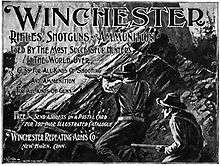Winchester Hotchkiss
The Winchester Hotchkiss was a bolt-action repeating rifle patented by Benjamin B. Hotchkiss in 1876 and produced by the Winchester Repeating Arms Company and Springfield Armory from 1878. The Hotchkiss, like most early bolt-actions, had a single rear locking lug integral with the bolt handle, but was unique in feeding multiple rounds from a tubular buttstock magazine similar to the Spencer rifle. The .45-70 Hotchkiss was acquired in limited numbers by the US Navy as the M1879, and (in a slightly modified version) by the US Army and several state militias as the M1883, making it the first center-fire bolt-action repeater to be adopted by any major military (the distinction of first bolt-action repeating rifle to be issued in great numbers as a standard military arm was the Swiss Vetterli 1869, which utilized very large rim-fire metallic cartridges).
| Winchester Hotchkiss | |
|---|---|
| Type | Service Rifle |
| Place of origin | United States |
| Service history | |
| Used by |
|
| Production history | |
| Designer | Benjamin B. Hotchkiss |
| Designed | 1876 |
| Manufacturer | |
| Produced | 1878 |
| Variants | Template:Plaintlist |
| Specifications | |
| Barrel length | 28.75 inches (73.0 cm) or 32.25 inches (81.9 cm) |
| Cartridge | .45-70 Government |
| Action | Bolt-action repeating rifle |
| Feed system | Tubular buttstock magazine |
United States military history
A joint production program was undertaken after the Winchester design passed United States Army Ordnance Department tests in 1878. Springfield Armory assembled rifles from Winchester actions and hardware with barrels and stocks manufactured at the armory. Sights, cleaning rods, and stock hardware were nearly identical to contemporary production for the single-shot "trapdoor" Springfield Model 1873. The Army ordered 513 Hotchkiss First Model Rifles for infantry units stationed on the western frontier including Texas and Fort Abraham Lincoln in the Dakota Territory. Springfield subsequently modified 501 of these rifles to First Model and Second Model Carbines for testing by cavalry units. Carbines have a shorter barrel and stock, and the rear sight is marked HC for Hotchkiss Carbine. The United States Navy ordered 1,474 First Model Rifles with 28.75 inches (73.0 cm) barrels rather than the 32.25 inches (81.9 cm) barrels on Army rifles.[1]
Hotchkiss First Model Rifles are identified by the circular knob safety and magazine cutoff on the right side of the stock. The knob weakened the stock and was replaced by two levers atop the receiver on Hotchkiss Second Model Rifles. The Navy purchased 999 Second Model Rifles in 1880 and 1881; and Springfield Armory converted most of the Army First Model Rifles to Second Model Carbines. A few rifles were manufactured for the Army with two piece stocks variously identified as the Model of 1883 or Third Model Hotchkiss Rifles. Army Hotchkiss rifles were withdrawn from service after the Springfield Model 1873 was judged superior to the Hotchkiss in 1883 field trials; but the Navy rifles remained in service until replaced by the M1895 Lee Navy.[1]
Other production
The Chinese Empire purchased 15,000 Winchester-Hotchkiss rifles in 1881. Winchester also produced a civilian sporting version of the Hotchkiss, likewise in caliber .45-70 Government, until 1899.
References
- Canfield, Bruce N. 19th Century Military Winchesters March 2001 American Rifleman pp.38-40
